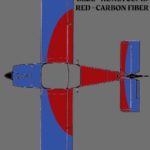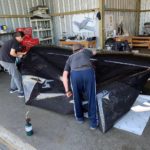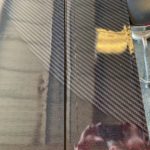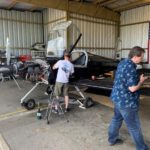By Tim Whitmire
We finished building the RV-14A about 1 ½ years ago. We decided on a vinyl wrap versus paint for the weight savings and price point. We shopped around and located a couple of companies. The companies we contacted in Seattle, Tucson and Orlando each had drawbacks. We ultimately found Palmer Signs is Roseville. They had wrapped several jet aircraft for the Reno air races, so we selected them.
After several emails and phones calls. I visited their shop in Roseville to settle on the final design. I wanted the carbon fiber pattern from my spinner to flow back and then blend with the carbon fiber weave from the instrument panel.

 After several design iterations, we came up with a pattern we both liked. Palmers designer kept offering to add in extra details, but I wanted to keep it simple and clean. I did add an Air Force shield on the spine of the aircraft. The capability of the printed vinyl is only limited by your imagination.
After several design iterations, we came up with a pattern we both liked. Palmers designer kept offering to add in extra details, but I wanted to keep it simple and clean. I did add an Air Force shield on the spine of the aircraft. The capability of the printed vinyl is only limited by your imagination.
 The vinyl itself is a 3M company product. The stock vinyl comes in a 60 inch wide roll and is 50 feet long. It starts out white and the design is printed on with a huge printer. The vinyl then goes through a dryer before a thin clear coat is applied. The whole sheet is 3 mils thick when finished. The vinyl can stretch up to 50% of its original size and has an adhesive back, but a little extra adhesive is used along the edges. They used about 710 square feet for my aircraft.
The vinyl itself is a 3M company product. The stock vinyl comes in a 60 inch wide roll and is 50 feet long. It starts out white and the design is printed on with a huge printer. The vinyl then goes through a dryer before a thin clear coat is applied. The whole sheet is 3 mils thick when finished. The vinyl can stretch up to 50% of its original size and has an adhesive back, but a little extra adhesive is used along the edges. They used about 710 square feet for my aircraft.
 The installation team made several trips out to measure and take pictures of the aircraft. The whole installation was scheduled for four to five days and ended up taking eight. There was a minor miscommunication about prep work that caused me to do a lot more than needed.
The installation team made several trips out to measure and take pictures of the aircraft. The whole installation was scheduled for four to five days and ended up taking eight. There was a minor miscommunication about prep work that caused me to do a lot more than needed.
 I understood I needed to spray paint all the edges where the vinyl would terminate. In reality, I just needed to paint the ends of the ailerons and flaps. All the paint lines then needed to be sanded to a feathered finish. The vinyl is so thin, the rivets, paint lines and any metal defects show right through, the pattern does help hide a lot.
I understood I needed to spray paint all the edges where the vinyl would terminate. In reality, I just needed to paint the ends of the ailerons and flaps. All the paint lines then needed to be sanded to a feathered finish. The vinyl is so thin, the rivets, paint lines and any metal defects show right through, the pattern does help hide a lot.
 Before beginning, we polished all the bare metal with Rolite to get it as clean as possible. Palmers further cleaned the skin with rubbing alcohol and a prep solvent. I removed the cowling, flaps, ailerons, rudder and elevators so they could be wrapped off the aircraft.
Before beginning, we polished all the bare metal with Rolite to get it as clean as possible. Palmers further cleaned the skin with rubbing alcohol and a prep solvent. I removed the cowling, flaps, ailerons, rudder and elevators so they could be wrapped off the aircraft.
 I stayed with the installation team for most of the time they were in the hangar. Sometimes for technical questions, others to temporarily install a flight control to get the vinyl alignment exactly right.
I stayed with the installation team for most of the time they were in the hangar. Sometimes for technical questions, others to temporarily install a flight control to get the vinyl alignment exactly right.
The final cost was $9148. The whole wrap only added 20 pounds to aircraft weight. They told me it could last indefinitely on a hangared aircraft. Stop by hangar B-21 on the southside if you would like to see the wrap up close.
Final thoughts: Great team to work with, I highly recommend Palmer signs if you are thinking about doing a wrap.
